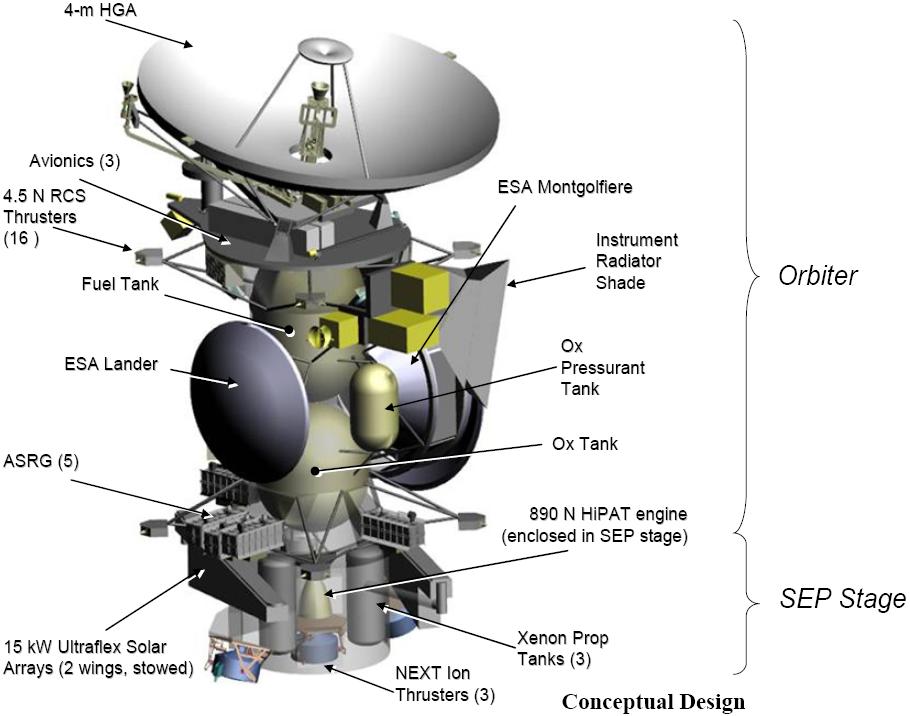Winston
Lorenzo von Matterhorn
- Joined
- Jan 31, 2009
- Messages
- 9,560
- Reaction score
- 1,748
From what I heard in another video, between the dense atmosphere and low gravity, human powered flight would be trivially easy. Note that the pressure suit shown in the title screen would not be needed, he just used an image that's readily available online:
[video=youtube;mtagVmPz4DI]https://www.youtube.com/watch?v=mtagVmPz4DI[/video]
Let's Colonize Titan
https://blogs.scientificamerican.com/guest-blog/lets-colonize-titan/
Titan Touchdown (Huygens probe)
[video=youtube;msiLWxDayuA]https://www.youtube.com/watch?v=msiLWxDayuA[/video]
[video=youtube;gdJcRQMqRdc]https://www.youtube.com/watch?v=gdJcRQMqRdc[/video]
Energy Options for Future Humans on Titan
https://arxiv.org/ftp/arxiv/papers/1707/1707.00365.pdf
Titan Saturn System Mission (TSSM)
[video=youtube;pL4LTFBO10Q]https://www.youtube.com/watch?v=pL4LTFBO10Q[/video]
With an estimated NASA cost of $2.5 Billion (FY07), TSSM was originally proposed to launch in 2020, get gravity assists from Earth and Venus, and arrive at the Saturn system in 2029. The 4-year prime mission would include a two-year Saturn tour, a 2-month Titan aero-sampling phase, and a 20-month Titan orbit phase.
The Titan Saturn System Mission (TSSM) was officially created in January 2009 by the merging of the ESA's Titan and Enceladus Mission (TandEM) with NASA's Titan Explorer 2007 study, although plans to combine both concepts date at least back to early 2008
TSSM was competing against the Europa Jupiter System Mission (EJSM) proposal for funding since then, however in February 2009 it was announced that NASA/ESA had given EJSM priority ahead of TSSM, although TSSM will continue to be studied for a later launch date, probably sometime in the 2020s. Detailed assessment reports of the mission elements as well as a specific concept for the lake landing-module called Titan Mare Explorer (TiME) have been released in February and October 2009, respectively.
https://en.wikipedia.org/wiki/Titan_Saturn_System_Mission

[video=youtube;mtagVmPz4DI]https://www.youtube.com/watch?v=mtagVmPz4DI[/video]
Let's Colonize Titan
https://blogs.scientificamerican.com/guest-blog/lets-colonize-titan/
Titan Touchdown (Huygens probe)
[video=youtube;msiLWxDayuA]https://www.youtube.com/watch?v=msiLWxDayuA[/video]
[video=youtube;gdJcRQMqRdc]https://www.youtube.com/watch?v=gdJcRQMqRdc[/video]
Energy Options for Future Humans on Titan
https://arxiv.org/ftp/arxiv/papers/1707/1707.00365.pdf
Titan Saturn System Mission (TSSM)
[video=youtube;pL4LTFBO10Q]https://www.youtube.com/watch?v=pL4LTFBO10Q[/video]
With an estimated NASA cost of $2.5 Billion (FY07), TSSM was originally proposed to launch in 2020, get gravity assists from Earth and Venus, and arrive at the Saturn system in 2029. The 4-year prime mission would include a two-year Saturn tour, a 2-month Titan aero-sampling phase, and a 20-month Titan orbit phase.
The Titan Saturn System Mission (TSSM) was officially created in January 2009 by the merging of the ESA's Titan and Enceladus Mission (TandEM) with NASA's Titan Explorer 2007 study, although plans to combine both concepts date at least back to early 2008
TSSM was competing against the Europa Jupiter System Mission (EJSM) proposal for funding since then, however in February 2009 it was announced that NASA/ESA had given EJSM priority ahead of TSSM, although TSSM will continue to be studied for a later launch date, probably sometime in the 2020s. Detailed assessment reports of the mission elements as well as a specific concept for the lake landing-module called Titan Mare Explorer (TiME) have been released in February and October 2009, respectively.
https://en.wikipedia.org/wiki/Titan_Saturn_System_Mission




